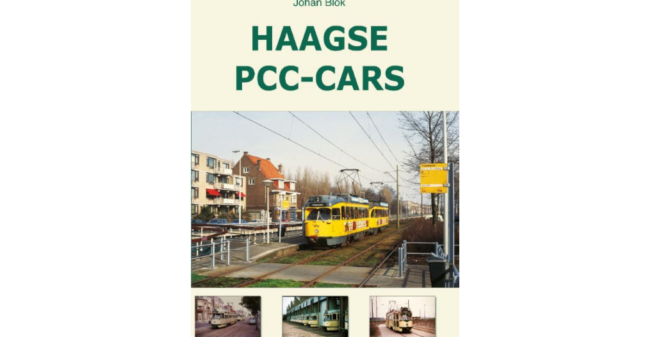
The three surviving tramway companies in the Netherlands in the large cities of the “Randstad” (Amsterdam, The Hague and Rotterdam) each went their own way in modernising their fleet from the 1950s onwards: Amsterdam initially relied on steerable three-axle cars with underframes from a Swiss patent, but after the appearance of the DÜWAG articulated car in 1956 switched to six- and eight-axle cars built in the country. Rotterdam initially remained faithful to its four-axle vehicles with central entry, but then turned to four- and six-axle vehicles from Switzerland, before larger numbers of DÜWAG six- and eight-axle vehicles were procured from the 1960s onwards, some of which were built under licence in the country itself.
The Hague began the modernisation in 1948 with a small series of conventional four-axle trams from domestic production, but then switched to American PCC railcars, the first of which arrived on European soil in 1947 in individual parts from the USA at the wagon factory “La Brugeoise et Nivelles” (BN) in Bruges, Belgium. BN had acquired the licence for such vehicles from the USA for both the construction and the technical equipment for Western Europe. The history of the original is well known, but one problem with its use in Europe was the width of 2.54 metres, which clashed with the possibilities of use on the track networks designed for 2.20 to 2.30 m wide vehicles. BN therefore created a narrower version with a width of 2.32 m and thus laid the foundation for successful use in Western Europe. The Belgian national light railway company SNCV, which used the prototype on standard gauge after initial test runs in Brussels, ordered a series of 24 railcars in 1949.
The Hague also showed interest, but first wanted to test the possible applications in detail. The first two prototypes for Den Haag were built at BN from two further “kits” that arrived in Belgium by ship from the USA. The door arrangement was changed from the original (front and centre) to front and rear, as the use of a conductor was planned in contrast to the USA. The cars had the so-called “standee windows” on the sides, which are often described as a characterising feature of a PCC car, but actually are not, as the original did not have them at first. “American” was the pedal steering and the accelerator gearbox, which gave the cars rapid acceleration.
As this trial was satisfactory, series production began in 1950 with an initial 22 units, which now had the classic door arrangement front and centre, since they were to be used in one-man operation, a novelty for Europe. Over the next 25 years, 210 PCC four-axle tramways built by BN, or their rebuilds and new foundations, were added to the Royal Residence in four further partial series. They differed from each other in various details, but had uniformly large and high side windows and also a narrow door at the rear to speed up passenger changes. The last 30 were motorised but did not have a driver’s cab, so that they were only to be used as the second car of a double traction and only had a single door at the front. All PCCs delivered from 1957 onwards in the “European look” were designed for use in a train set. Two-car trains were standard, three-car trains were possible, but were not used beyond trial runs and special runs. Incidentally, four Tw of the second series delivery received DÜWAG bogies with tandem drives in place of the classic PCC bogies on a trial basis.
This history alone makes it clear that the PCC trams in The Hague offer a lot of material for a description, which the author uses in a detailed way on more than 300 pages. The book is therefore primarily aimed at vehicle specialists, who can then really find out everything about the planning, origins, use and whereabouts of the vehicles. The table of contents already shows how a clear presentation is achieved by dividing the book into ten chapters. Chapters 5 to 10, which describe the individual series, are structured according to a uniform scheme, which makes it easy to search for details and to compare the series with each other. The curriculum vitae of each vehicle is recorded in “boxes”.
Chapter 4 begins with a clear treatment of the characteristics that apply to all series. Not everyone interested in The Hague vehicles will know their history in America and the rest of Europe, so that the first two chapters provide the basic knowledge. The author, who has already written numerous publications on The Hague trams but also on vehicles of other companies, also deals quite extensively with the technical features of the PCC. Numerous photos and drawings make this subject understandable even for the non-technical experts.
There is also a short chapter on the network of The Hague Tramway with two plans, so that one can also learn something about the operating conditions of the cars. The appendix summarises the technical data, lists the preserved cars and gives an overview of the tram lines that were served by PCC. A list of abbreviations and sources concludes the book, which is excellent in print and processing.
All chapters are illustrated with more than 400 good photos in sufficient size and about two thirds in colour, which show not only the vehicles and their “inner life” but also their routes through the city. Those interested in Germany should not be put off by the language, as a great deal becomes clear in the context of the illustrations. Today, translation programmes are also a reliable help.
Anyone interested in the subject should not hesitate to get hold of this publication – there will definitely be no regrets.
Author: Johan Block
Editorial: Uitgeverij de Alk, Alkmaar (NL) 2022
304 pages, format 30.0 x 21.0 cm, hardback
Price: 45,00 €
ISBN: 978 905961258 7
04.04.2023
